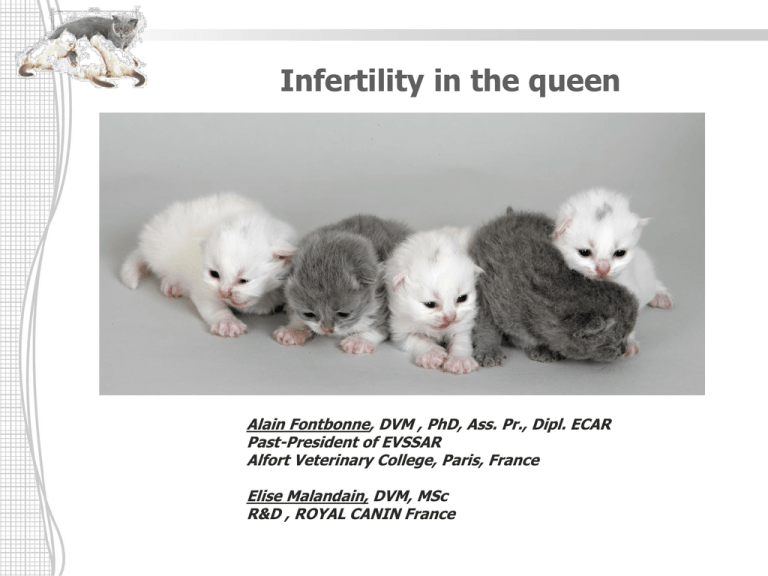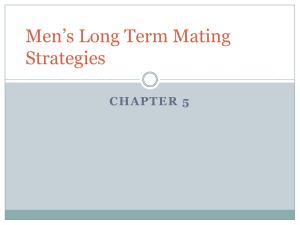
Infertility in the queen
Alain Fontbonne, DVM , PhD, Ass. Pr., Dipl. ECAR
Past-President of EVSSAR
Alfort Veterinary College, Paris, France
Elise Malandain, DVM, MSc
R&D , ROYAL CANIN France
Infertility in the queen
Introduction
Anestrus
Hyperestrus
Mating failure
Ovulation failure
Lack of fertilization
Early embryonic death
Introduction
Nowadays
Pure bred cats become more and more popular
People are more professional:
They ask veterinarians to provide more technical help
It is necessary to have an accurate diagnosis
procedure
Begin with the most frequent causes
Follow a chronological order
Infertility in the queen
Introduction
Anestrus
Hyperestrus
Mating failure
Ovulation failure
Lack of fertilization
Early embryonic death
Anestrus
Usual in northern hemisphere during the short days period
Physiological anestrus is longer in long haired breeds
False anestrus
Silent heat:
Normal hormonal events without obvious estrus behaviour
Timid queens; low on social scale; crowding
Differentiate from pseudopregnancy: vaginal cytology, serum
progesterone
Perform vaginal smears and hormonal assays
More difficult to appreciate than in the bitch:
Generally progesterone blood level does not increase except if a spontaneous
ovulation occurs .
Anestrus
Primary anestrus
Check eventual drugs
administration:
- Progestagens (given
when the queen
suffers from prurit)
- Antifungic drugs
(ketoconazole)
Congenital problem
- Clinical examination
- Ultrasound
examination
Check that
ovaries are
present
Beware of
neutered
queens
Anestrus
Primary anestrus
Environmental problems
Frequent travel, exhibition
Overcrowding,
temperature/ventilation
Antagonistic social interactions
- Social life (stress)
- Lack of light
Stress
Transport
Delayed puberty!
Persians may reach puberty near 1214 months.
Anestrus
Secondary anestrus
Racial variations
Some persian queens may exhibit only one or two
heat periods per year
Changes in the living environment
Light period
Below 10 hours of light per day anoestrus
Persistant corpus luteum
Continuous progesterone secretion
Normally <1ng/L
Estrus induction
Indications
Medical indications
Prolonged anestrus
Zootechnical indications
Try to breed queens at the non-breeding period
Long-haired queens
Problem due to the « group effect »
Methods
Light stimulation
Hormonal treatments:
gonadotropins: eCG=PMSC
Light stimulation
Interest
Is a « physiological » method
No adverse reactions
Methods
A 14 hours day light helps to get two monthly estrous
periods
Needs 3 weeks before the beginning of heats
Avoid continuous light
Light stimulation
In practice
Hurni makes the proposal of
-one month of 9 hours of day light
-followed by one month of 14 hours of day light.
Programs using dis-continuous lighting programs 12
h-1h-1h-9h seem to give better results.
In all cases, the best results are obtained when
light stimulation is associated with a social stimulus
(other queens + males).
Infertility in the queen
Introduction
Anestrus
Hyperestrus
Mating failure
Ovulation failure
Lack of fertilization
Early embryonic death
Hyper-estrus
Siamese cats
Social factors
Queens that are not in heat may accept a mating
Aetiology :
Successive phases of follicular growth
Hormonal secreting follicular cysts:
GnRH, hCG, follicular puncture, unilateral
ovariectomy
Granulosa Cells Tumor
Drugs
Infertility in the queen
Introduction
Anestrus
Hyperestrus
Mating failure
Ovulation failure
Lack of fertilization
Early embryonic death
Mating failure
Before doing any complementory investigation,
check that the mating has occured
In practice, mating failure is THE big cause of
infertility in the queen
Mating failure
Environnemental causes
Transport of the queen leading to interruption of
estrous behavior
Time necessary for adaptation
Non-experimented or scared male cat...
…or agressive queen!
-Organise transport
-Help....
Mating failure
Physical causes in the male
Gingivitis or pain of the jaws
Penis stricture due to hair
Anatomical abnormalities of the genital tract
Infection
Retrograde ejaculation
Urinari calculi
Pain during ejaculation
Mating failure
Lack of libido of the male
Hypothyroidism
Hormonal treatments
Age
Lack of A vitamine, iodide, poly insaturated fatty acids
Weight excess
Low efficiency of usual treatments(testosterone IM)
Try with another male cat
AI
Infertility in the queen
Introduction
Anestrus
Hyperestrus
Mating failure
Ovulation failure
Lack of fertilization
Early embryonic death
Ovulation failure
Mounting
Not repeated enough
Too long period between two successive
mountings
1 coitus leads to ovulation in only 50% of the cases
Before going through many complementary
investigations,the breeder has to know the
frequency and intensity of mountings, and to
check if the queen exhibits a normal post-coital
reaction.
Ovulation failure
Progesterone secretion (ovarian tumors, luteal
cysts)
Some queens may have follicular maturation under
progesterone secretion.
This level can be sufficient to prevent ovulation,
without preventing estrus:
It is useful to assay progesteronemia before a mating:
<1ng/L
May induce false interpretation of the ovulation
detection after mating
To confirm ovulation: progesterone testing !!
35
progesterone ng/L
30
25
20
15
10
5
0
0
1
2
3
4
Days post ovulation
5
6
7
Ovulation failure
Sedatives/anesthesic drugs
Used in agressive queens
May prevent the LH peak
Stress
A stressed queen may not ovulate, even when
exhibiting a normal post-coital reaction
Try eventually to bring the male and to allow him
to mate the queen , after a period of adaptation
Infertility in the queen
Introduction
Anestrus
Hyperestrus
Mating failure
Ovulation failure
Lack of fertilization
Early embryonic death
Lack of fertilization
Diagnosis
Ovulation has to be confirmed
Mating has to be confirmed
Negative early pregnancy diagnosis using
ultrasonography
Impossible to differenciate from early embryonic death
Cause
Spontaneous ovulation, before presenting the queen to
the male
Relatively rare
MALE INFERTILITY
Male infertility
Genetical problems
« 3 colors » male cat (tortoise shell)
Infertility:
Abnormalities of semen (Cf. AI)
Treatments are of low efficiency (GnRH)
Presence of spicles on the penis
Under the control of androgens
Male infertility
Miscellaneous problems
Urinary calculi,
Increased temperature of the testis,
Testicular tumors
Inflammatory diseases ( check testis and prepucial
cavity).
Back pain
Gingivitis!!!
Male infertility
Drugs
Cortico-steroids, anabolic steroids, antifungic
compounds, progestagens
Age
Too young or too old !
Male infertility: procedure
History
Previous treatments (ketoconazole, progesterone,
anti-androgens)
Previous matings
Clinical examination
External genitalia
Check the urine
Semen evaluation
See AI
Infertility in the queen
Introduction
Anestrus
Hyperestrus
Mating failure
Ovulation failure
Lack of fertilization
Early embryonic death
Cystic endometrial hyperplasia
First stage of pyometra
Due to hormonal disorders
- Repeated pseudo pregnancies
- Drugs (pills, injection)
Secondary, infection and accumulation of
fluid = pyometra
Particularly frequent in Siamese
queens
Leads to infertility
Ovulation occurs, without
implantation
No other clinical signs….
Infertility in the queen
Introduction
Anestrus
Hyperestrus
Mating failure
Ovulation failure
Lack of fertilization
Early embryonic death
Abortion/Pregnancy arrest
• Early embryonic resorption and further
abortion most often unnoticed in the queen:
infertility is the main sign
• Scientific knowledge on this topic is very
limited (Schlafer 2003)
Early embryonic death
In practice
Try to diagnose pregnancy as early as possible
D 10
D 11
D 13
D 15
Hormonal problems
Hormonal problems
• Hypoluteoidism:
Very rare in queens
Progesterone therapy may be used
be careful not to counteract with normal parturition
Pregnancy
Infectious diseases
Infectious diseases
• Viruses:
FelV the most common cause:
Testing and housing procedures
FIV:
Outdoors catteries
Feline Herpes virus
Feline calicivirus:
Many different strains - Cases in vaccinated animals ?
Rarely suspected (Van Vuuren et al. 1999)
Feline panleucopenia virus:
Beware of attenuated live vaccines injected in pregnant
queens
Feline coronavirus:
Uncommon cause of abortion in cats (Ström-Holst 2002)
Infectious diseases
• Bacteria:
Probably under-diagnosed
E.coli, Staphylococcus sp., Streptococcus sp.:
- potential causes of abortion
(Root-Kustritz 2006)
Chlamydophila felis ?
Its role is unclear : experimentally: suppurative placentitis
may occur (Schlafer 2003)
Treatment: Doxyxyclin 28 days (Dean et al. 2005)
Diagnosis is difficult
Vaccination does not protect against infection
Salmonella sp.
Bartonella henselae (Guptill et al. 1998)
• Parasites:
Toxoplama gondii (Root-Kustritz 2006)
Cytauxzoon felis ? (Weismann et al. 2007)
Infectious causes of « abortion »
In practice
Test the queen for FelV-FIV
Serology-PCR for Chlamydiosis, FHV
Vaginal smear: many neutrophils ?
Bacterial identification: vaginal culture
with a urinary catheter : infuse a few drops of sterile
fluid in the vagina, and aspirate them again
Chromosomal problems
Chromosomal defects
• May cause abortion or fetal death
37, X0
Trisomies
• If repeated abortions:
karyotype the aborted fetuses
(Romagnoli 2003)
Nutritional causes
Proteins and Taurine
Proteins
Higher level diet recommended for reproduction
Taurine
During gestation
Essential amino acid selectively transported
through the placenta
A deficiency may induce early embryonic resorption
(before 25 days) (Sturman 1991, Dieter 1993, Champion et al. 2005)
- with or without an increase in relaxine plasma level
Arachidonic acid
Essential in cats
Can not be synthesized in quantity (limiting
action of desaturase δ 6)
Not enough to cover high needs
But adults cat can survive with a deficiency
During pregnancy
A deficiency IMPAIRS reproduction in queens
Essential for gestation and viability of kittens! (Pawlosky1996)
No effect on males reproduction
,
Copper (Fascetti 1998, 2000)
• Role on reproduction:
Has been particularly studied in cats
Direct link between Copper and reproductive performances
Some chemical forms are not assimilated
- Copper oxide for example
Under 10 mg/kg, progressive decrease of fertility, prolificity and
vitality of kittens
To ensure the best assimilation
Some authors recommend to use chelated forms
- Trace element link with an amino acid
- Less competition for absorption
Early embryonic death
In practice
Test the queen for FelV
Vaginal smear: many neutrophils ?
Bacterial identification: vaginal swabbing:
Tom Cat Catheter : inect a few drops of sterile fluid in
the vagina, and aspirate them again
Infertility in the queen : summary
The infertile queen
1. Before the heat period
Conduct a good clinical and genital examination
Progesterone assay: level has to be basal
Vaginal smear: interoestrus
Ultrasonography : the ovary should be homogeneous
or should not show any « big » follicular structure; the
uterus should be normal
Check the history of the male (previous litters ? )
Test FeLV
The infertile queen
2. During the heat period
Vaginal smear : confirms that the queen is in estrus
Try to observe the mating
-Is there enough mating? Frequency?
Ultrasonography: helps to check follicular maturation
and ovulation
In summary: the infertile queen
3. Four days after the last mating
Progesterone assay : +/- 5ng/L
35
progesterone ng/L
30
25
20
15
10
5
0
0
1
2
3
4
Days post ovulation
5
6
7
In summary: the infertile queen
4. Early pregnancy diagnosis:
14 days after mating
Progesterone assay : >10ng/L
Check male’s fertility
Check uterus
Pyometra, CEH?
Return to estrus in less than 18 days
indicates failure to ovulate
Return to estrus 35-45 days
pseudopregnancy
Elevated progesterone without confirmed
pregnancy
Causes: CEH, endometritis, early embryonic loss,
male infertility
Ultrasound exam at 14-21 days post-breeding
In summary: the infertile queen
5. If the queen undergoes a resorption or abortion
Investigate infectious diseases: FeLV, FIV, FPV, FHV-1,
FCV, Toxoplasma, etc.
Clinical examination
- FeLV
- Herpesvirosis
Bacterial identification from the vagina
- Specific
Chlamydiosis
- Non specific
Progesterone assay
Thank you for your attention !










